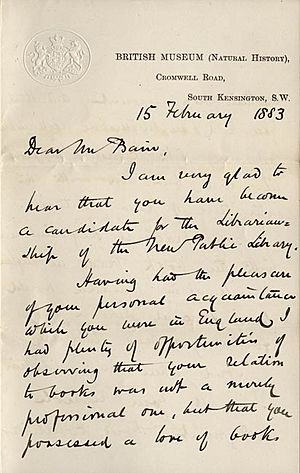William Carruthers (botanist) facts for kids
William C Carruthers (born May 29, 1830 – died June 2, 1922) was a British scientist who studied plants, both living and fossilized. He was known as a botanist and paleobotanist.
A Life in Science
William Carruthers was born in Moffat, Scotland. His father, Samuel Carruthers, was a merchant. William went to Moffat Academy and then studied at the University of Edinburgh. He worked as a tutor to pay for his studies.
In 1854, he started studying to become a minister. However, he soon decided to focus on natural sciences instead. He became a teacher of botany at the New Veterinary College in Edinburgh. He also worked as an assistant secretary for the Royal Society of Edinburgh.
In 1859, Carruthers joined the botany department at the British Museum. He became the head of the department in 1871. He held this important role until he retired in 1895. During his time, he made sure the museum's huge plant collections were moved safely to their new home in South Kensington. He also stopped attempts to move them to another place called Kew.
Carruthers married Jeanie Moffat in 1865. They had three children together.
He wrote many scientific papers about different plants. He studied trees like oaks, tiny water plants called diatoms, and mosses. He also studied ancient fossil plants, including ferns, cycads, and other extinct plants like Calamites and Lepidodendron. He was also an expert on graptolites, which are fossils of small sea creatures. In 1867, he wrote an article about them for a famous science book.
In 1871, he was chosen to be a Fellow of the Royal Society, which is a very respected group of scientists. He was also the president of the Geologists' Association from 1875 to 1877. Later, he led the Linnean Society, a group for naturalists, from 1886 to 1890. He was also a member of the Botanical Society of Edinburgh. In 1907, he received a special PhD degree from the University of Uppsala in Sweden.
His Religious Beliefs
William Carruthers was a very active member of the Presbyterian Church. He was part of its Committee on Publications for many years. He also edited a magazine called Messenger for Children from 1876 to 1921. He was very interested in the history of a religious movement called Puritanism.
His Views on Evolution
William Carruthers had some doubts about Charles Darwin's theory of evolution. In 1876, he gave a speech where he said that plant fossils did not seem to support evolution. He pointed out that there were no "missing links" or in-between forms in the plant fossil record. He also noted that many different kinds of flowering plants seemed to appear "suddenly and at the same time" in the fossil record.
This speech became well-known. It might have even made Darwin call the origin of higher plants an "abominable mystery" in 1879. Even today, scientists are still working to fully understand how flowers evolved. While we have learned a lot about evolution, the exact steps for flower evolution from fossils are still a mystery. In 1886, Carruthers gave another speech. He argued that plants had not changed much over time by comparing modern plants with ancient ones found in Egyptian tombs.
Archives
William Carruthers' papers and notes are kept in several places. His official records from his time as head of the Botanical Department are at the Natural History Museum Library and Archives. Some of his notes and drawings are at the Cadbury Research Library in Birmingham. Letters about Carruthers are also held at the University of Edinburgh.


